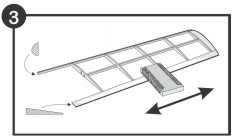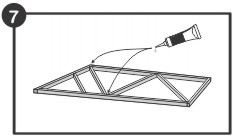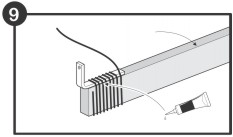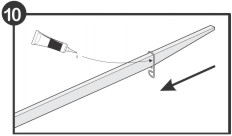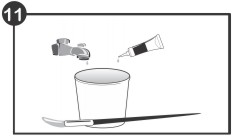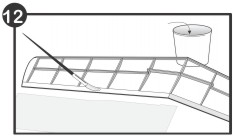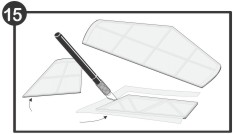FLYING HINTS
1. Although this model WILL take off from the ground under it’s own power, you will get a longer flight with a hand launch. It takes a big burst of power out of the rubber motor to rise off the ground.
2. If the model turns too much to the right or left, take the rudder off and glue it back on with a little bit of turn in the other direction.
Kit No. 4301 CLOUD BUSTER
No. 3 of Beginner's Series
Wing Span: 17½" Length: 15¼"
Wakefield, MA 01880 U.S.A.
www.guillow.com
Copyright 2000 by PAUL K. GUILLOW, INC.
Build the other kits in this series and continue to “step your way up” to great model building and flying.
Paint glue mixture
through tissue.
Un-pin and pick the wing frames up from the building surface. First, carefully sand the trailing edge of the wing as shown so that the edge becomes thin, then round the leading edge with your sandpaper. See the airfoil shape below.
Build the wing mount next, remember that this has to be strong enough to hold up the wing on your model so use plenty of glue. Note: The strips for the wing mount are not square - they are a little higher than they are wide.
Build the stabilizer and rudder over the shaded parts of the plan as you did the wing frames. Don’t forget to use wax paper and plenty of pins. Gently sand the parts smooth after the glue has dried.
OK, your finished building the parts and need to get ready to put tissue covering on the surfaces. Get a small paintbrush out and mix up a 50% water - 50% white glue mixture in a small cup. Stir it well. Now is a good time to do any last minute sanding!
Use ½ water
and ½ white glue
Now slide the rear hook on the fuselage from the back. Look at the side view on the plan to see where it goes. Put glue over the wire to hold in place.
Use plenty of
glue for strength!
Glue the thrust bearing on straight to the bottom of the front end of the fuselage (see plan). When it’s dry, wrap it with thread and coat the thread with glue to make it strong. This nose bearing will be under some strain when the rubber motor is wound.
Trim off
extra string
AFTER
glue has
dried!
While the glue is drying, start making the Fuselage of the Cloud Buster. Carefully cut the back end of the stick to look like the Side View below. Hint: Hold wood over plan and mark with a pencil before cutting.
You will need to PIN the parts down to a “building board” to hold them during construction (while the glue is drying). By pinning them as shown above, you will get nice un-warped finished parts. Hint: Lay a piece of wax paper over your plan before you start building so the frames won’t get stuck to the paper.
Glue the wing mount to the fuselage 1/2" back from the nose of the plane. Glue the stabilizer to the rear of the body as shown. When dry and the stabilizer is secure, carefully glue the rudder on top of the stabilizer. Take your time and get these on straight!
Your model will have a longer flight if you fly it out of your hand.
The take off from the ground needs that first burst of power and uses a lot of energy.
Your glider is finished and you are ready to balance it and test fly! Balance the glider as shown by putting a finger under each wing tip where shown by the black arrows on the top view. If needed, add clay to the nose or tail until the glider balances level.
Build the left and right wings over the shaded parts of the plan. Glue all the wing ribs (except W2) where they belong over the shaded layout. Use pins as shown in step 1 to help hold the parts down while the glue is drying.
Now, carefully glue the wing to the wing mount. Look at the model from the front to make sure it's going on straight. You can use some scrap balsa sticks under the wing tips (as shown) to hold the wing in the correct position while the glue dries. Glue well !!! Mist the Wing and Wing mount (ONLY) with water.
Sand the wings center edges a little to make a slight angle. When they fit together nicely with the Diherdral Gauge under the end, you can go ahead and glue them together. You can pin the wing down as shown above to hold it while the glue is drying.
Cut a piece of tissue paper slightly oversized for the wing half. Paint your glue/water mixture on the perimeter of the bottom side of the one wing as shown above. Proceed quickly to the next step before the glue dries.
When the joint between the wing halves is dry, glue the wing brace W8 between the W3 ribs. Now glue rib W2 into place and put one more coat of glue on these five important joints for strength.
Now cover the top of the wing with tissue the same way (slightly overlap tissue in middle) ! When the glue has dried and the tissue is adhered securely, trim off the excess tissue with a sharp modelers knife or razor blade. Be careful !
Tissue cover and trim the stabilizer, rudder and wing mount as you did the wing. The stabilizer is covered on the top side only BUT the rudder & wing support should be covered on BOTH sides with tissue.
Your Cloud Buster is ready to fly ! Wind the prop about 50 turns and let's give it a test flight. The model should "sail pretty" but if the flight is kind of bumpy or has dips, put some clay in the wing mount (see side view) to weight the nose a bit.
Use Dihedral Gauge
to set correct wing angle.
Fly your Cloud Buster on a calm day, it’s built very light and will get tossed around in strong winds.
If your model dives, take weight off nose (or put some on tail) to achieve a nice level flight. Once your model is gliding well, you can wind the rubber 250 turns or so to get a longer, more exciting flight. Enjoy the flying and have fun !!!!!!!
Just about any type of glue will work with your model - white glue, wood cement, "super glue", etc. The building time will vary depending on the glue you use and how fast it dries.
Carefully lay tissue down on the wing half and smooth out any big wrinkles with you finger. Paint another coat of glue mixture THROUGH the tissue onto the wood. Repeat with the other half of the wing bottom. When glue is dry, trim off excess tissue.
Trim off
excess tissue
when dry !
Glue rudder on
AFTER stabilizer
has dried a bit !
Slide the propeller shaft thru the thrust bearing, put on the propeller and then bend the end of the wire. Put your wheels onto the landing gear, bend the wire to hold them on, then glue your landing gear to the fuselage behind the wing mount. Tie your rubber motor into a loop and put on model.
"notched"
end
of propeller



